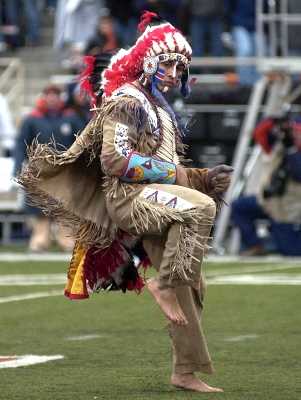Robert Warrior, director of the American Indian Studies Program and the Native American House, said he believes the placement of the signs helps make the exhibit more meaningful for the audience. The signs are displayed outside instead of in an indoor exhibit.
"Sometimes art doesn't really have a context, and that's why it's not successful," said Heap of Birds.
Heap of Birds also touched on the meaning of the "Native Host" series on the University campus and discussed the concept of the Chief as a focal point.
"Commercialism and festival ... the real chief isn't about that," said Heap of Birds. "Humbleness is behind what a chief is."
Heap of Birds explained that chiefs give up all of their private property to their people and lead "through generosity." His own name "Heap of Birds" came from a Cheyenne chief.
In Cheyenne tradition a chief had no personal property. All that he and his family owned was offered to tribal members on request (this is sometimes a demand even today) once the chief took the position. Chiefs were selected because of their generosity. Many men did not wish to become chief because of this point. Chiefs were chosen by chiefs, but could decline.
A chief is far beyond one person and should reflect an honor and allegiance--as well as truth, tradition, listening, openness, and good way--to a whole people.
But this doesn't play into America's founding myths, of course. According to these myths, it was our generals vs. their chiefs. We fought them in a more-or-less equal match-up of military men. They were tough as nails, but we were tougher, so they lost and forfeited their lands. Now we enshrine them for their toughness to prove how great we were.
This mythology falls apart if you realize a chief was more of a shepherd than a king. "We defeated some Indian who gave away his possessions? What was he...a Commie pinko? Real men don't give things away; they take things. They amass wealth and power. Why in the world are we commemorating this loser?"
For more on the subject, see Team Names and Mascots.
Below: "Just like a real chief, I urge you to root for victory, buy more merchandise, and donate money to the university."


3 comments:
I tend to try to refer to cheifs as "leaders" in discussion rather than "cheifs". I think it deflects the strong image of "Indian Chief" somewhat. But I still of course use Chief when it is an actual title.
(and as seen above, I can still misspell it sometimes, too)
Nowadays, tribes may have a president or chairperson rather than a chief or sachem. Therefore, it's wise to avoid the term "chief" unless you know the person is an actual chief.
Post a Comment